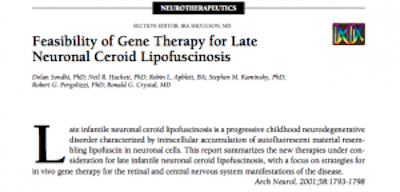ABOUT BATTEN DISEASE
Symptoms
Batten Disease was first described in 1826. It is the common name for a group of diseases known as neuronal ceroid lipofuscinoses or NCLs.
Thought to be one of the most common neurodegenerative rare diseases, it remains an unsolved mystery. There is neither a successful treatment nor a cure. Children diagnosed with this disease are missing a gene that is responsible for eliminating the buildup of cellular waste in the brain and central nervous system. These genetic mutations disrupt the cells ability to dispose of wastes. Over time, the buildup of proteins and lipids (fats) causes these affected cells to become damaged and die. The death of these cells is devastating to the brain and body’s function. Individuals suffer from progressive neurological impairment.
There are five major forms of Batten Disease:
-
- Infantile: Onset 6 months – Life Expectancy: 5-10 years of age.
- Classic Late Infantile: Onset 2-5 years – Life Expectancy: 8-12 years of age.
- Variant Late Infantile: Onset 2-5 years – Life Expectancy: 8-13 years of age.
- Juvenile: Onset 5-10 years – Life Expectancy: Early 20s
- Adult (Very Rare): Onset before 40 years of age: Life Expectancy varies.
Batten Disease is rarely diagnosed quickly and it is often mistaken for epilepsy, developmental disabilities or even schizophrenia. Onset is characterized by early vision loss, seizures, clumsiness, and behavioral changes. Batten Disease causes progressive deterioration with loss of sight, seizures, atrophy, marked decline of cognitive functioning, hallucinations, and loss of mobility. Sadly, children with Batten Disease are born with all these functions intact and experience a rapid loss of function after a period of normal childhood development.
Batten Disease is a recessive inherited disorder. Both parents must carry the defective gene. In order to be affected, a child must inherit a copy of the bad gene from each parent. A child who inherits just one gene is a carrier but is otherwise unaffected by the disease. Unfortunately, they can unknowingly pass the gene on to their children. A blood test can positively diagnose the disease. Occasionally a skin biopsy may be necessary.
Prognosis
Today there is no cure for Batten Disease. Because of widely varying genetic mutations the arc of Batten disease can vary tremendously for each person. Sadly, until more strides are made in research, treatment and cures, Batten always results in early death. However there are exciting clinical trials to assist in the reversal of symptoms. Seizures can be reduced or controlled with anticonvulsant drugs, and other medical difficulties can be treated as they arise. At the same time, physical and occupational therapies help individuals remain functioning as long as possible.
Science & Research
Cornell Clinical Trial
Below is a sample of the research and documentation on the Cornell Study and Clinical Trial. Please download the PDF for more information (Right Click the link to save to your computer, or click on the document to open in a new window)
Cornell-Trial-All-publications-Data
NIH Workshop on “Translational Research Priorities for Infantile (CLN1) and Late Infantile (CLN2) Forms of Batten Disease”
November 11-12 2010
Author: David A Pearce
Vice President of Research, Sanford Health
Director, Sanford Childrens Health Research Center, Sanford Research USD
Professor, Department of Pediatrics, Sanford School of Medicine of the University of South Dakota
The PDF is from a recent workshop dedicated to INCL and LINCL. Please download the document for more information (Right Click the link to save to your computer, or click on the document to open in a new window)


